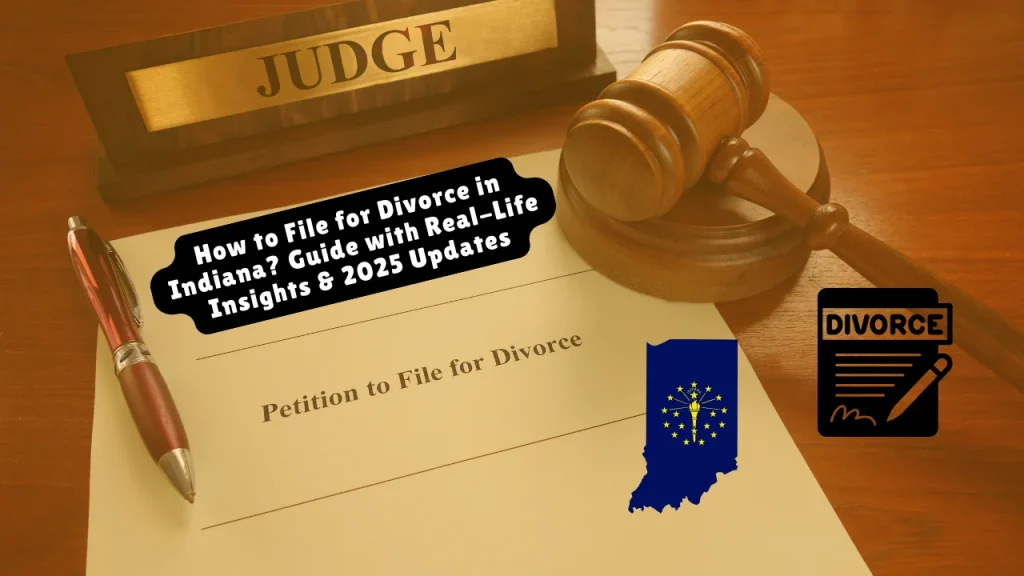How to File for Divorce in Indiana? Guide with Real-Life Insights & 2025 Updates
You (or your spouse) must have lived in Indiana for at least six months and in the county where you’re filing for at least three months. You file a Petition for Dissolution of Marriage with your county clerk, serve the papers to your spouse, wait at least 60 days, and resolve issues like property, custody, and support — either through agreement or court hearings.
Below is a full breakdown of the process, with real-life scenarios, updated laws for 2025, emotional survival strategies, and official resources to guide you.
Table of Contents
Why This Guide Matters
Indiana sees over 25,000 divorces annually, and its divorce rate (about 2.7 per 1,000 residents in 2022) is slightly above the U.S. average. Divorce can feel overwhelming — but clarity can save you time, money, and stress.
This guide blends legal precision with human insight, drawing on real Indiana cases to help you navigate both the legal and emotional journey.
Indiana Divorce at a Glance
Residency Requirements
You or your spouse must meet both:
- Live in Indiana (or an Indiana military base) for at least 6 months before filing.
- Reside in the filing county for at least 3 months.
Indiana Code § 31-15-2-6
Examples:
- Julia moved from Illinois to Indianapolis. After 4 months, she wanted to file but had to wait 2 more months to meet Indiana’s residency rule.
- Priya moved to Marion County in January. She can file by July (6 months in state + 3 months in county).
Related article: Do I Have to Sign Divorce Papers?

Grounds for Divorce
Indiana is primarily a no-fault divorce state:
- Most common: Irretrievable breakdown of the marriage — no blame required.
- Rare fault-based grounds: felony conviction, impotence at marriage, or incurable insanity (lasting 2+ years).
⚖️ Insight: No-fault divorces are faster, less adversarial, and more common. Fault-based grounds don’t usually impact property division but may affect spousal maintenance.
How Much Does Divorce Cost?
- Filing fees: $150–$250, depending on county.
- Attorney fees: Usually $200–$350/hour.
- DIY divorce: Possible if uncontested — can save thousands.
Timeline: How Long Does It Take?
- Minimum: 60 days (state-required waiting period).
- Uncontested: Usually finalized in 60–90 days.
- Contested: Can take 6–18 months, depending on complexity and court schedules.
Related article: How to Tell Your Wife You Want a Divorce?
Step-by-Step Process to Divorce in Indiana
Step 1: File the Paperwork
- File a Petition for Dissolution of Marriage + Appearance Form at your county clerk’s office.
- Include details: marriage date, residency, children, property, and requested relief.
- Forms available online or at the courthouse: Indiana Courts Divorce Forms
Step 2: Serve Your Spouse
You must legally notify (“serve”) your spouse using:
- Certified mail
- Sheriff’s deputy
- Professional process server
They then have 20–30 days to respond. If they don’t respond, you can request a default judgment.
Step 3: Request Temporary Orders (if needed)
While the case is pending, you can request temporary orders for:
- Child custody/support
- Spousal maintenance
- Use of marital home
Example: Marco got temporary custody of his kids and use of their Evansville home during the divorce.
Step 4: Negotiate or Mediate
- Uncontested divorce: Draft a settlement agreement covering property, debts, and childcare. You can waive the final hearing if everything is agreed.
- Contested divorce: Court-ordered mediation is common. If mediation fails, the case goes to trial.
Step 5: Final Hearing & Decree
- Uncontested: Judge approves your agreement after 60 days.
- Contested: Both sides present evidence, and the judge issues binding orders in a Final Decree of Dissolution of Marriage.
Key Legal Issues
Property Division
Indiana follows equitable distribution — meaning property is divided fairly, not necessarily equally.
- Marital property: Anything acquired during marriage.
- Separate property: Inheritances, pre-marriage assets — unless commingled.
Factors courts consider:
Contributions to acquiring assets
Economic circumstances after divorce
Debts/liabilities
Bad conduct dissipating assets (like gambling)
Child Custody & Support (with 2025 Updates)
Indiana courts prioritize the best interests of the child, considering:
- Child’s age & health
- Parent–child relationships
- School & community ties
- History of domestic violence
- Child’s wishes (if age 14+)
New 2025 Law (HEA 1626): Judges must issue detailed custody findings, explaining why the arrangement serves the child’s best interests.
Custody Types:
- Joint or sole custody.
- Child support calculated using the Income Shares Model, combining both parents’ incomes.
- Estimate here: Indiana Child Support Calculator
Spousal Maintenance (Alimony)
Indiana’s spousal maintenance is limited — awarded only if:
Recipient is incapacitated.
Recipient cares for a disabled child.
Short-term rehabilitative support (≤3 years) for education/training.
Real-Life Indiana Divorce Scenarios
- Sarah & Mark in Fort Wayne: Agreed on joint custody & 50/50 property split. Filed jointly, finalized in 75 days, spending under $1,000 thanks to cooperation.
- Liam & Sofia in Bloomington: Uncontested, child-free divorce. Split home & savings. Finalized in 63 days.
- Anya & Raj: Contested with kids. Judge awarded joint legal but primary physical custody to Anya, citing Raj’s frequent travel and prioritizing school stability.
- Complex Assets: A Fort Wayne couple disputed a $500K family business. Judge awarded 60% to the managing spouse, balanced by retirement assets to the other.
Emotional & Practical Survival Strategies
Legal Aid & Resources:
- Indiana Legal Services — Free help for low-income residents.
- Indiana Courts Self-Service — Forms & guides.
- Indiana State Bar Association — Find a lawyer.
Emotional Support:
- Therapy: Indiana Behavioral Health — Sliding-scale counseling.
- Support Groups: DivorceCare and other Indiana-based programs.
- National Domestic Violence Hotline (if needed): 📞 800-799-7233.
Practical Tips:
- Document everything — texts, expenses, incidents.
- Use parenting apps like OurFamilyWizard to track communication & schedules.
- Prioritize self-care: exercise, social support, time for yourself.
Key Takeaways
Residency is non-negotiable: 6 months (state) + 3 months (county).
No-fault divorce is simpler and faster — prioritize cooperation where possible.
Property division focuses on fairness, not just 50/50 splits.
Custody disputes now require judges to give detailed findings under 2025 law — prepare evidence of your parenting role.
Always consider professional legal advice for complex cases.
Official Resources
- Indiana Courts Divorce Forms
- Indiana Child Support Calculator
- Indiana Code Title 31: Family Law
- Find Your County Clerk
A Final Note
Every divorce is unique — and often painful. While this guide gives you a clear roadmap, always consult a qualified Indiana family law attorney to protect your rights and help you navigate the process. Remember: this is not just a legal journey, but an emotional one — and you’re not alone.
Disclaimer: This guide is for informational purposes only and does not constitute legal advice. Please consult a licensed Indiana attorney for advice specific to your situation.
About the Author

Sarah Klein, JD, is a former family law attorney with over a decade of courtroom and mediation experience. She has represented clients in divorce, custody cases, adoption, Alimony, and domestic violence cases across multiple U.S. jurisdictions.
At All About Lawyer, Sarah now uses her deep legal background to create easy-to-understand guides that help families navigate the legal system with clarity and confidence.
Every article is based on her real-world legal experience and reviewed to reflect current laws.
Read more about Sarah
